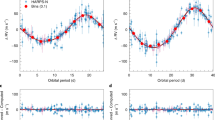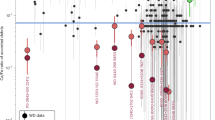Abstract
AT least two Earth-sized planets have been discovered around the 6-ms pulsar PSR1257 +12 (ref. 1), which, like millisecond pulsars in general, has probably been spun up by accretion of material from a companion star. In addition, two 'star-vaporizing' millisecond pulsars (SVPs), 1957 + 20 (ref. 2) and 1744–24A (refs 3, 4), show evidence of mass outflows from their low-mass companions, which are thought to be vaporized by pulsar radiation. Building on this, we suggest a model for the formation of planets around millisecond pulsars such as 1257 + 12, which no longer have stellar companions. We present detailed hydrodynamical models which suggest that planet formation can occur either in a low-mass X-ray binary progenitor to a progenitor of an SVP when the neutron star is accreting material driven off its companion by X-ray irradiation (refs 5, 6), or after a pulsar has formed and is vaporizing its companion5,7–9. In both cases a circum-binary disk is created in which planets can form on a timescale of 105–106 years10 (which is short compared with the binary evolution time-scales of the parent systems) and the planets can survive a second phase in which the companion star moves towards the pulsar and is completely vaporized5.
This is a preview of subscription content, access via your institution
Access options
Subscribe to this journal
Receive 51 print issues and online access
$199.00 per year
only $3.90 per issue
Buy this article
- Purchase on Springer Link
- Instant access to full article PDF
Prices may be subject to local taxes which are calculated during checkout
Similar content being viewed by others
References
Wolszczan, A. & Frail, D. A. Nature 355, 145–147 (1992).
Fruchter, A. S., Stinebring, D. R. & Taylor, J. H. Nature 333, 237 (1988).
Lyne, A. G. et al. Nature 347, 650–652 (1990).
Nice, D. J., Thorsett, S. E., Taylor, J. H. & Fruchter, A. S. Astrophys. J. 361, L61 (1990).
Ruderman, M., Shaham, J. & Tavani, M. Astrophys. J. 336, 507 (1989).
Tavani, M. Nature 351, 39 (1991).
Tavani, M. & Brookshaw, L. Astrophys. J. 381, L21–L24 (1991).
Tavani, M. & Brookshaw, L. Astrophys. J. (submitted).
Banit, M. & Shaham, J. Astrophys. J. (in the press).
Safronov, V. S. & Ruzmaikina, T. V. in Protostars & Planets (eds Black, D. & Matthews, M.)959–980 (University of Arizona Press, Tucson, 1985).
Kennel, C. F. & Coroniti, F. V. Astrophys. J. 283, 694 (1984).
Arons, J. & Tavani, M. Astrophys. J. (submitted).
London, R. A., McCray, R. & Auer, L. H. Astrophys. J. 243, 970 (1981).
Tavani, M. Astrophys. J. 379, L69–L73 (1991).
Monaghan, J. J. Computer Phys. Rep. 3, 71–124 (1985).
Fruchter, A. S. & Goss, M. Astrophys. J. 384, L47–L51 (1992).
Balbus, S. & Hawley, J. Astrophys. J. 376, 214 (1991).
Shu, F. H. Lubow, S. H. & Anderson, L. Astrophys. J. 229, 223–241 (1979).
Lin, D. N. C., Woosley, S. E. & Bodenheimer, P. H. Nature 353, 827 (1991).
Ryba, M. F. & Taylor, J. H. Astrophys. J. 380, 557 (1991).
Tavani, M. in X-Ray Binaries and the Formation of Binary and Millisecond Radio Pulsars (eds van den Heuvel, E. P. J. & Rappaport, S.) (Kluwer, Dordrecht, in the press).
Tavani, M. in Proc. 2nd GRO Science Workshop (ed. Shrader, C.) (NASA, Greenbelt, in the press).
Goldreich, p. & Ward, W. R. Astrophys. J. 183, 1051 (1973).
Safronov, V. S. Evolution of Protoplanetary Cloud and the Formation of the Earth and Planets (Nauka, Moscow, 1969); (Engl. transl. NASA TTF-677).
Tavani, M. Astrophys. J. 366, L27–L31 (1991).
Author information
Authors and Affiliations
Rights and permissions
About this article
Cite this article
Tavani, M., Brookshaw, L. The origin of planets orbiting millisecond pulsars. Nature 356, 320–322 (1992). https://doi.org/10.1038/356320a0
Received:
Accepted:
Issue Date:
DOI: https://doi.org/10.1038/356320a0
This article is cited by
-
Planets around pulsars: A review
Astrophysics and Space Science (1994)
Comments
By submitting a comment you agree to abide by our Terms and Community Guidelines. If you find something abusive or that does not comply with our terms or guidelines please flag it as inappropriate.



